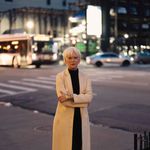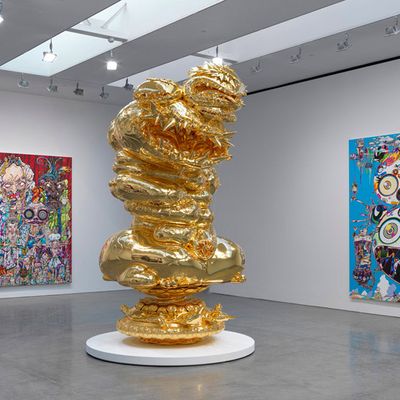
There’s always a theme-park-like quality to any Takashi Murakami show: the cutesily deranged, insistent candy colors and anime characters, which both seem to be derived from and a perversely heightened embodiment of the canned commercial imagery that, one way or another, is what binds everyone in the world together these days. It’s also part of what makes him so popular. Kids (and collectors) of all ages have found his branded joyfulness — from Disney-inspired riffs to his actual Louis Vuitton bags — pretty irresistible, even if you often suspect, if you don’t happen to be Japanese, that you’re not quite in on the joke. But then that’s part of the fun: He’s down with misinterpretation. As long as you find something interesting to enjoy about it, then it might as well be a small world after all.
A week ago, Takashi Murakami opened his latest exhibition, “In the Land of the Dead, Stepping on the Tail of a Rainbow,” at Gagosian on West 24th Street, and it’s a different kind of theme park — a much darker one, since Murakami is working now in the shadow of the Fukushima nuclear disaster. Yes, that’s right: This is Murakami’s nuclear-meltdown period. A few days before it opened, as it all was just being unpacked, Murakami agreed to walk me through a bit of his self-consciously serious new work, maybe help me a bit with my misinterpretation. He was nattily dressed in a saggy tweed suit and polka-dot shirt and took me on a tour, sometimes speaking to me directly in English and sometimes, when he wanted to make his thoughts clearer, through a scrupulous young woman holding a pen and notebook. She wanted to get down what he said properly before translating.
After the 2011 Fukushima disaster his tone has become darker and more mystical: He’s said that after the catastrophe, he began planning this show realizing that in dark times “religion and fairy tales and things like that are actually a necessity.”
So this show is less about the shiny disruptions and diversions of global capitalism, and less an effort to flatten out the distinctions of “high” and “low” culture in order to be considered Japan’s answer to Andy Warhol (much to the chagrin of many in the West). Instead, it’s an effort to look back to how Japanese art has responded in the past to natural disasters, such as the Great Ansei Earthquake of 1855. It’s a different kind of movie for Murakami, something more apocalyptic, less about globalized accessory culture, and closer to Rashomon or The Walking Dead. He’s a fan of both. Killing zombies, he notes, is therapeutic: “You just want to release the frustration!” he says to me, miming stabbing the undead in the head. “Before the Fukushima disaster, his main theme was sort of the relationship between the U.S. capitalism and himself — the relationship and struggle between them,” says the translator of Murakami. “But after the disaster happened he felt he had to work with more of the theme of chaos.”
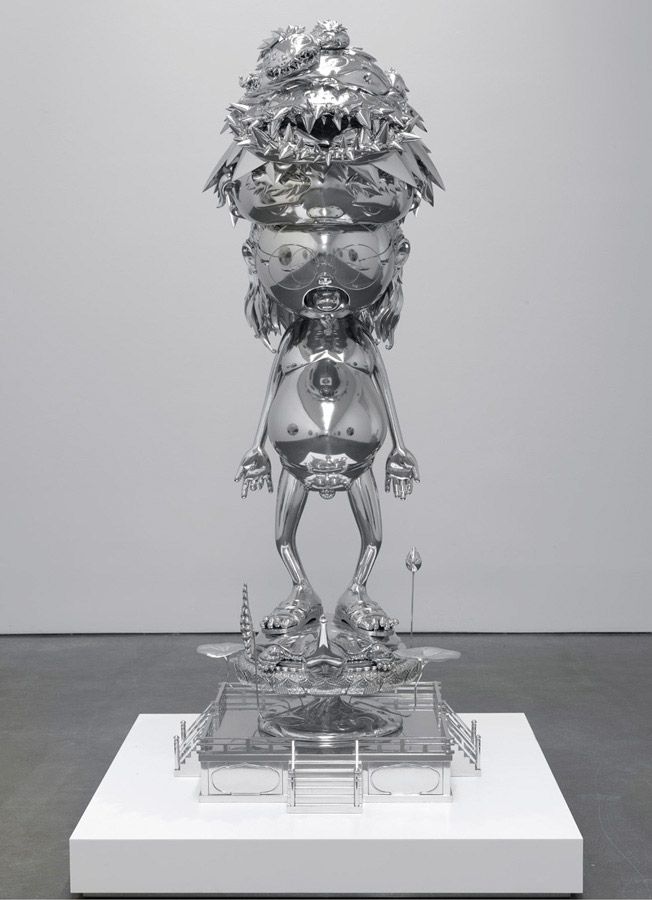
When you arrive, you’re drawn through a life-size replica of a sanmon (sacred gate). If it looks like something from a film or an elaborately themed sushi restaurant — he calls it a “stage set for viewing paintings” — that’s because Murakami hired the guy who worked under the set designer for Rashomon to build it. The Kurosawa film takes place, he explains, in the Heian period (roughly 794 to 1185 AD), “a time which was socially really disruptive and a lot of war was going on,” translated the translator. “It was not a peaceful time, but that was exactly when art was thriving in Japan.” (The Japanese imperial court, in Kyoto at the time, was then said to be at its artistic zenith.) It looks like it’s been through a siege or two, with broken planks and cracked pillars. “They’ve been burning it, torching it, and painting it,” says the translator. “Some places making a kind of blood color,” adds Murakami, in English. “Maybe it looks like blood. I don’t know.”
The paintings around it are very large, and in historical style (it’s good to remember that Murakami has a PhD in traditional Japanese painting from Tokyo University of the Arts) depicting all manner of disaster, including big waves — tsunamis, like the one that inundated Fukushima, happened many times before. Off to the right are two towering demonic statues. Dark days, you see. Even in West Chelsea.
Ideally, Murakami explains to me, this gate would just be the beginning of a larger, quasi-mystical complex. “I’d been wanting to make a temple,” he says, “kind of a sightseeing thing … when people are traveling and have to go looking at museums and temples.” If he can get someone to pay for it, and the right location, he’d like to “make a big temple for my painting,” which would be built, in traditional fashion, beyond the gate (which, the translator translates, has a sign over the doorway: The gate that eats the demons’ dreams). “This is my first step, this is the gate,” he says. “And then, you know, if we can make big-budget temple … ”
The gallery’s next room centers on a towering, gleaming, and disturbing golden sculpture of one of his iconic characters, Mr. Dob, which was inspired by Mickey Mouse. Here Mr. Dob is thoroughly deconstructed and not cute at all anymore.
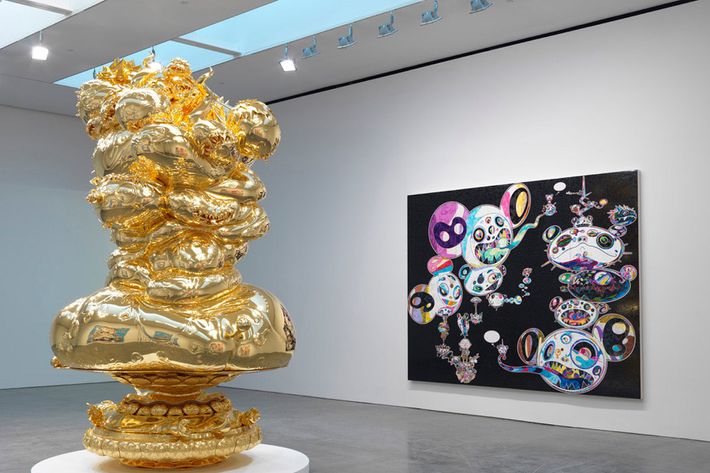
But something else has happened, too, besides his mood: In some ways he’s moving beyond making artworks to make his points. Jellyfish Eyes, the first in a planned trilogy of feature films directed and produced by Murakami, came out last year, and that has changed how he thinks of his work. The paintings around the Mr. Dob statue are clearly in a crisis but don’t necessarily tell a story in the way his works once tried to with art. “Now that he,” meaning Murakami, “has learned to make feature-length films and tell stories that way, he’s not really creating narrative in his painting or sculpture work,” says the translator (who instead of directly translating what he says, using “I”, summarizes it, using “he”). “When he wants to tell a story he can make a film now. It’s more about ideas and themes.” I ask what the little bunnylike creature at the bottom of an electric-blue painting of blobby, zonked-out-looking faces with gaping mouths called Tan Tan Bo— In Communication is saying in its cartoon chat bubble.
“Are you okay?” reads the translator.
The answer is clearly: No. Murakami laughs and says: “They’re puking!” he says of the big, blobby faces that the bunny is addressing. “That’s why he is saying, Are you okay?”
The third and final room is lined with a series of more decorative (and decorous) circular paintings and an unflattering silver, gleaming anti-heroic nude (especially when it comes to the depiction of his genitals) statue called Invoking the Vitality of a Universe Beyond Imagination. What is realistically depicted are his sandals: Murakami actually wears ones like those at home. “Yeah, yeah, really cheap ones,” he says.
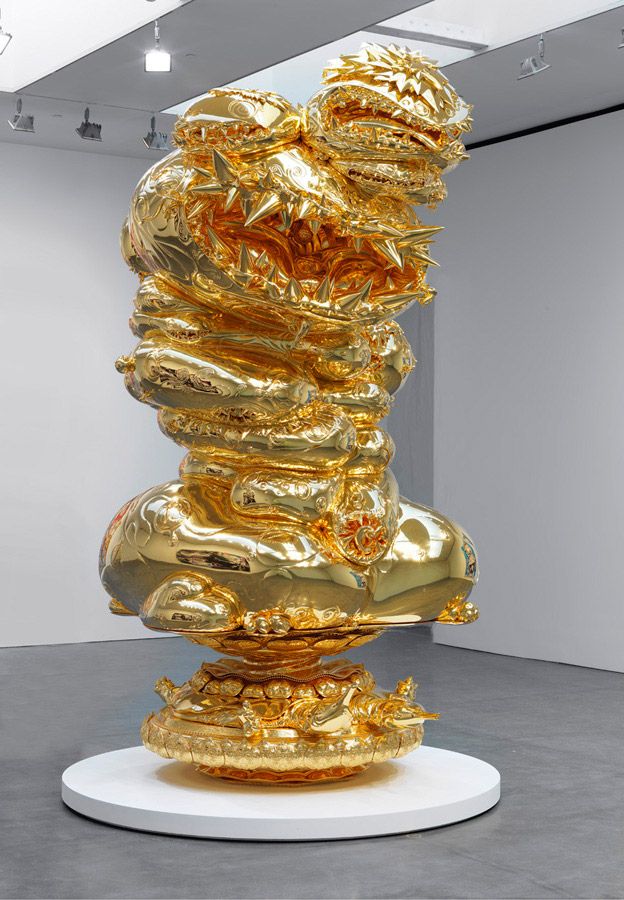
Murakami is famous for running his art production in a workshop model, if not as a factory exactly, with artisans for hire making things to his specifications. (The whole operation is known as the Kaikai Kiki Co.) The paintings in this room were made in his Long Island City satellite studio, where he has a team of assistants. Those in the other room had to be imported from the main atelier in Japan. “The difference between this and the other work is that type of detail can’t be done in New York, they aren’t skilled enough,” without his supervision, says the translator. “He’s really supervising everything in Japan.”
I say it must be hard to keep people engaged to achieve his exacting standards.
“True, true,” Murakami says, with his hammering laugh, before explaining a bit more in Japanese and letting the translator finish up: “He’s made feature films now and worked with film crews and will continue working with them for two years and three years.” After a while “they lose focus and motivation.” Murakami smiles. “And so now he’s employing a contract staff for a year or something like that for a specific project. For this Gagosian show he employed a specific set of people for one year so then they can keep the motivation going.”
We return to the first room, and I ask him where he’d want to build his temple complex ideally. Would it be like his own version of Murakamiland? He answers by talking about his own experience working for Disney. “You know, when I was a student I was working at Tokyo Disneyland,” he says. “And this experience is very deep. My first piece in contemporary art world” — which was a big block of yellow resin covered in a swarm of plastic toy soldiers called Polyrhythm (1991) — was inspired by that job. He saw artisans who were working with toxic materials there, creating Disneyland’s fantasy worlds, and “many people didn’t have a nose. It looked like their noses were melting. It was scary. And I thought, Woooow, this is the reality, background to Disneyland.”



